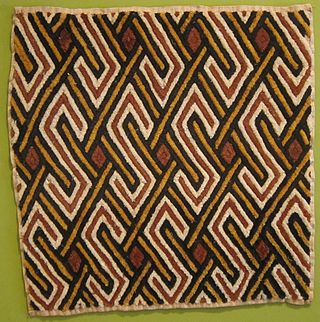
Cape Coast is a city, fishing port, and the capital of Cape Coast Metropolitan District and Central Region of Ghana. It is one of the country's most historic cities, a World Heritage Site, home to the Cape Coast Castle, with the Gulf of Guinea situated to its south. According to the 2021 census, Cape Coast had a settlement population of 189,925 people. The language of the people of Cape Coast is Fante.

Kente refers to a Ghanaian textile made of hand-woven strips of silk and cotton. Historically the fabric was worn in a toga-like fashion by royalty among the Ewe and Akan. According to Ashanti oral tradition, it originated from Bonwire in the Ashanti region of Ghana. In modern day Ghana, the wearing of kente cloth has become widespread to commemorate special occasions, and kente brands led by master weavers are in high demand. Kente is also worn in parts of Togo and Ivory Coast by the Ewe and Akan people there.

Ghana is a country of 33.48 million people and many native groups, such as:

The Mfantsefo or Fante are an Akan people. The Fante people are mainly located in the Central and Western regions of Ghana, occupying the forest and coastal areas. Their land stretches from the Pra estuary in the west to the Accra borders in the east. The Fante can be broadly categorized into two groups - the Borbor Fante and the non-Borbor Fante. Over the last half century, due to fishing expeditions, Fante communities have been established as far as Gambia, Liberia and even Angola. Major Fante cities in modern Ghana include Kasoa, Winneba, Agona Swedru, Tarkwa, Oguaa, Edina (Elmina), Mankessim, Sekondi, and Takoradi.
The Fante Confederacy refers either to the alliance of the Fante states in existence at least since the sixteenth century, or it can also refer to the modern Confederation formed in 1868. The Confederation is seen as one of the first and most prominent self-rule movements in Ghana and the entirety of Africa. Its mission was to shake off colonialism and establish a modern free democratic state.
Osei Bonsu also known as Osei Tutu Kwame was the Asantehene. He reigned either from 1800 to 1824 or from 1804 to 1824. During his reign as the king, the Ashanti fought the Fante confederation and ended up dominating Gold Coast trade. In Akan, Bonsu means whale, and is symbolic of his achievement of extending the Ashanti Empire to the coast. He died in Kumasi, and was succeeded by Osei Yaw Akoto.
Akan is a group of several closely related languages within the wider Central Tano languages. These languages are the principal native languages of the Akan people of Ghana, spoken over much of the southern half of Ghana. About 80% of Ghana's population can speak an Akan language as a first or second language, and about 44% of Ghanaians are native speakers. There are populations of polyglots in Ghana who speak an Akan language as a third language. They are also spoken in parts of Côte d'Ivoire.
The Akan people are a Kwa group living primarily in present-day Ghana and in parts of Ivory Coast and Togo in West Africa. The Akan speak dialects within the Central Tano branch of the Potou–Tano subfamily of the Niger–Congo family. Subgroups of the Akan people include: the Agona, Akuapem, Akwamu, Akyem, Anyi, Ashanti, Baoulé, Bono, Chakosi, Fante, Kwahu, Sefwi, Wassa, Ahanta, and Nzema, among others. The Akan subgroups all have cultural attributes in common; most notably the tracing of matrilineal descent in the inheritance of property, and for succession to high political office.
The Efutu are an Akanized Guang people that are the original inhabitants of present-day Ghana. They founded the coastal area about 1390 C.E. The Efutu are found in Awutu, Adina, Senya-Beraku and Winneba and their main occupation is fishing. Like most Guans, they were somewhat absorbed into the greater Akan culture and adopted Akan names via annexing and military campaigns as the Akan were natural warriors. Similar to the Akuapem people of the Eastern Region of Ghana who are ruled by an Akan Abusua but was originally ruled by their own Guan kings. They also have adopted the Fante version of some Akan institutions and the use of some Fante words in their rituals. Before Akanization, the Simpa Kingdom was formed about 1400 AD.

The Dutch Gold Coast or Dutch Guinea, officially Dutch possessions on the Coast of Guinea was a portion of contemporary Ghana that was gradually colonized by the Dutch, beginning in 1612. The Dutch began trading in the area around 1598, joining the Portuguese which had a trading post there since the late 1400s. Eventually, the Dutch Gold Coast became the most important Dutch colony in West Africa after Fort Elmina was captured from the Portuguese in 1637, but fell into disarray after the abolition of the slave trade in the early 19th century. On 6 April 1872, the Dutch Gold Coast was, in accordance with the Anglo-Dutch Treaties of 1870–71, ceded to the United Kingdom.

Adinkra are symbols from Ghana that represent concepts or aphorisms. Adinkra are used extensively in fabrics, logos and pottery. They are incorporated into walls and other architectural features. Adinkra symbols appear on some traditional Akan goldweights. The symbols are also carved on stools for domestic and ritual use. Tourism has led to new departures in the use of symbols in items such as T-shirts and jewellery.
The Mankessim Kingdom (1252–1844) was a pre-colonial African state in modern-day Ghana. It is regarded as the heartland of the Fante people, and operated as capital of the Fante Confederacy in the 19th century. The town of Mankessim still exists, and is located in the Central Region of Ghana, about an hour and a half drive west of Accra. The Mankessim Kingdom's influence was quite vast; it extended to the whole of the Fante people, and at times the entire coast of modern-day Ghana.
Articles related to Ghana include:

The Akyem are an Akan people. The term Akyem is used to describe a group of four states: Asante Akyem, Akyem Abuakwa, Akyem Kotoku and Akyem Bosome. These nations are located primarily in the eastern region in south Ghana. The term is also used to describe the general area where the Akyem ethnic group clusters. The Akyem ethnic group make up between 3-4 percent of Ghana's population depending on how one defines the group and are very prominent in all aspects of Ghanaian life. The Akyem are a matrilineal people. The history of this ethnic group is that of brave warriors who managed to create a thriving often influential and relatively independent state within modern-day Ghana. When one talks of Ghanaian history, there is often mention of The Big Six. These were six individuals who played a big role in the independence of Ghana. Of the big six, people of Akyem descent made up the majority.

African textiles are textiles from various locations across the African continent. Across Africa, there are many distinctive styles, techniques, dyeing methods, and decorative and functional purposes. These textiles hold cultural significance and also have significance as historical documents of African design.

The Asante Empire, today commonly called the Ashanti Empire, was an Akan state that lasted from 1701 to 1901, in what is now modern-day Ghana. It expanded from the Ashanti Region to include most of Ghana and also parts of Ivory Coast and Togo. Due to the empire's military prowess, wealth, architecture, sophisticated hierarchy and culture, the Ashanti Empire has been extensively studied and has more historic records written by European, primarily British, authors than any other indigenous culture of sub-Saharan Africa.
In many parts of West Africa, there is an old chieftaincy tradition, and the Akan people have developed their own hierarchy, which exists alongside the democratic structure of the country. The Akan word for the ruler or one of his various courtiers is "Nana". In colonial times, Europeans translated it as "chief", but that is not an exact equivalent. Other sources speak of "kings", which is also not entirely correct, especially in the case of the said courtiers. The term "chief" has become common even among modern Ghanaians, though it would be more correct to use the expression "Nana" without translation wherever possible.
Kwadwo/Kwadjo/Kojo is an Akan masculine given name originating from the Akan people, meaning born on a Monday. As an Akan given name, with the Akans being a large ethnic group consisting of various tribes such as the Fante, Asante, Akuapem among others, Kwadwo/Kwadjo is sometimes written as "Kojo", Kwadwo or Kwadjo and is also used less frequently as a family name. People born on particular days are supposed to exhibit the characteristics or attributes and philosophy, associated with the days. Kwadwo has the appellation Okoto or Asera meaning peace. Thus, males named Kwodwo tend to be peaceful.

Asafo are traditional warrior groups in Akan culture, based on lineal descent. The word derives from sa, meaning war, and fo, meaning people. The traditional role of the Asafo companies was defence of the state. As the result of contact with European colonial powers on the Gold Coast, the Fante, who inhabit the coastal region, developed an especially complex version of the concept in terms of its social and political organization based on martial principles, and with elaborate traditions of visual art, including flag banners with figurative scenes, and designs alluding to historical events or proverbs.

The documented history of Elmina begins in 1482 with an agreement between the Portuguese navigator Diogo de Azambuja and the ruler of Elmina, called Caramansa by the Portuguese. In it, the Portuguese were allowed to build the first European fortress in sub-Saharan Africa. For the next 150 years until the conquest by the Dutch in 1637, Elmina was the capital of the Portuguese bases on the Gold Coast, then for about 250 years the capital of the Dutch Empire in West Africa. Since the capture of the lease for the two fortresses of Elmina by the Ashanti in 1701, the city was also important to the Ashanti Empire. Until the 19th century, Elmina was one of the most populous cities in the Gold Coast, surpassing Accra and Kumasi. The trade in gold, slaves and palm oil brought the city into direct contact with Europe, North America, Brazil and, through the recruitment of soldiers, also with Southeast Asia. It was not until the takeover and destruction of the city by the British in 1873 that Elmina lost its prominent position in the Gold Coast.


















